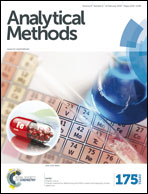5-Aminofluorescein doped polyvinyl alcohol film for the detection of formaldehyde in vegetables and seafood
Abstract
A simple, sensitive and low cost sensor has been developed for the determination of formaldehyde using a polyvinyl alcohol (PVA) film with entrapped 5-aminofluorescein (Fl-NH2). The fluorescence intensity (excitation and emission wavelengths at 444 and 520 nm, respectively) of the sensing film increased with formaldehyde concentration. Under the optimal conditions, the PVA sensing film exhibited a linear response in the concentration range from 5.0 to 100.0 μg L−1 (R2 = 0.9978) with a detection limit of 3.820 ± 0.079 μg L−1 and a good sensor-to-sensor reproducibility (RSD < 2.5%). This sensor was applied for the analysis of formaldehyde in soak water from vegetables (9 samples), fruits (2 samples) and seafoods (2 samples). Formaldehyde was detected in only 2 samples, one from Chinese cabbage (7.5 ± 3.5 μg L−1) and the other from broccoli (19.1 ± 2.0 μg L−1), but for the rest of the soak water samples being tested formaldehyde was not detected. Good recoveries (88 ± 13% to 113.5 ± 4.7%) were obtained with spiked samples. This developed PVA sensing film is not only simple to use, by immersing into a sample solution without any sample pretreatment step, but also reusable for up to 10 times (RSD < 3.0%).


 Please wait while we load your content...
Please wait while we load your content...